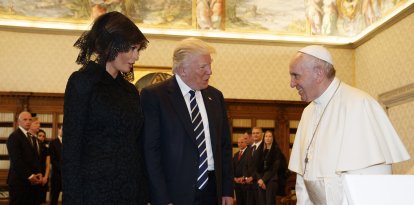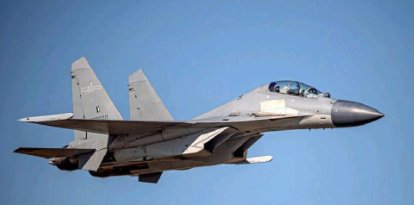An IRGC plane lands in Buenos Aires
Mahan Air and the Argentine government, once again in the firing line.

An aircraft of the Mahan Air company / Wikipedia.
On June 6, a plane with 19 crew members (14 Venezuelans and 5 Iranians) landed at Buenos Aires international airport with an alleged load of Mexican auto parts for Volkswagen. The plane had been operated by Mahan Air -an Iranian company sanctioned by the US Treasury Department- until last February, when it was sold to the Venezuelan company Emtrasur, part of the Conviasa conglomerate, also under US sanctions. According to press reports, the aircraft is insured by the Iranian company Razi Insurance Co.
Mahan Air’s reputation is well known in the aviation market. Recently, Fred Shaheen, Boeing’s former senior global trade adviser, wrote in The Wall Street Journal that “some major Iranian airlines like Mahan… directly supported IRGC activities.” As reconstructed by the Argentine daily Infobae from data taken from FlightRadar24, from February 11 to June 6, this plane landed in Venezuela, Paraguay, Mexico, Myanmar, Pakistan, Iran, Nigeria and Russia (even after the invasion of Ukraine), among other countries. The passing of hands between two anti-American allied nations is likely a ploy to circumvent sanctions. However, international spy agencies alerted Argentine authorities about this observed aircraft.
At least some of the Iranians on board appear to be related to the Al-Quds Force, the global arm of the Iranian Revolutionary Guard Corps (IRGC). In all likelihood, all of them are soldiers or agents of the ayatollah regime. Special attention was paid to the pilot, Gholamreza Ghasemi Abbas, whose name coincides with that of a former member of the IRGC and is a member of the board of directors of Qeshm Fars Air, an airline used in the past by Iran to transport weapons to Syria. Also striking was the presence on the plane of Venezuelan military officer Cornelio Trujillo Candor, a historical loyalist of the late former president Hugo Chávez, a key sponsor of the strategic ties between Caracas and the Islamic Republic of Iran.
May be all of this is just a mere coincidence and the national government is not involved in anything shady related to this sanctioned plane manned by Iranians that landed in Buenos Aires days ago. But given that Iran struck twice in Argentina -against the Israeli embassy in 1992 and against the AMIA Jewish headquarters in 1994-, given the strong presence of Hezbollah in the region, and given the ideological proximity of the various Kirchnerist governments to the Ayatollah regime in Tehran, one is left wondering.
On June 8, the Argentine authorities granted permission for the flight to take off to Venezuela, with a technical stopover in neighboring Uruguay, but this country denied it entry due to global alerts, so the plane returned to Buenos Aires to refuel. But neither Britain’s Shell nor Argentina’s YPF agreed to a fuel supply given the global sanctions on Iran. Based on legal presentations and requests made by the opposition and the entity that represents the country’s Jewish community, the Argentine justice system prohibited the departure of the flight and withheld the passports of the entire crew. That was on June 10. By this time, the status of the mystery plane had taken on great public interest.
Argentine government officials sought to downplay the incident. The newly-appointed head of the espionage agency and former defense minister Agustín Rossi told the pro-government channel C5N that the Iranians were flight instructors. When asked by the interviewer if that was based on information, Rossi replied “No, it’s my deduction.” Security Minister Aníbal Fernández assured that the Iranian pilot of the plane had no relationship with the IRGC: “There is a particular indication about Gholamreza Ghasemi, one of the crew members, who has a namesake with participation in the Quds, in the condition of a namesake, not of something else.” Rafael Resnick Brenner, who quickly emerged as the lawyer for the crew of the Venezuelan-Iranian plane, was a state official during a previous Kirchner government. Ten days after the landing, government spokeswoman Gabriela Cerruti tried to close the matter, saying that the government had taken the correct measures. “The rest is part of a novel that each journalist or each media wishes to make,” she stated.
This episode took place simultaneously with the Summit of the Americas, held in Los Angeles from June 6-10. In said meeting, Argentine President Alberto Fernández publicly protested the exclusion of Cuba, Nicaragua and Venezuela promoted by the Biden Administration. His harangue was applauded by Venezuelan President Nicolás Maduro from Tehran, where he was to sign a twenty-year strategic cooperation agreement. “Alberto Fernández has made a firm, clear, brave speech and put everything in his place,” he said during an interview with Hispan TV. He “he put the icing on the cake.” Interestingly, who was holding the presidency in Alberto Fernández’s absence was his hostile vice president Cristina Fernández de Kirchner, who in 2013 negotiated a controversial memorandum of understanding with Iran. For this, she was accused of “treason against the country” by prosecutor Alberto Nisman, who shortly after died of a shot to his head in circumstances that have not yet been fully clarified, but it is widely suspected that it was a murder case.
May be all of this is just a mere coincidence and the national government is not involved in anything shady related to this sanctioned plane manned by Iranians that landed in Buenos Aires days ago. But given that Iran struck twice in Argentina -against the Israeli embassy in 1992 and against the AMIA Jewish headquarters in 1994-, given the strong presence of Hezbollah in the region, and given the ideological proximity of the various Kirchnerist governments to the Ayatollah regime in Tehran, one is left wondering.
Editor's note: this article was originally published on June 17.
RECOMMENDATION





















